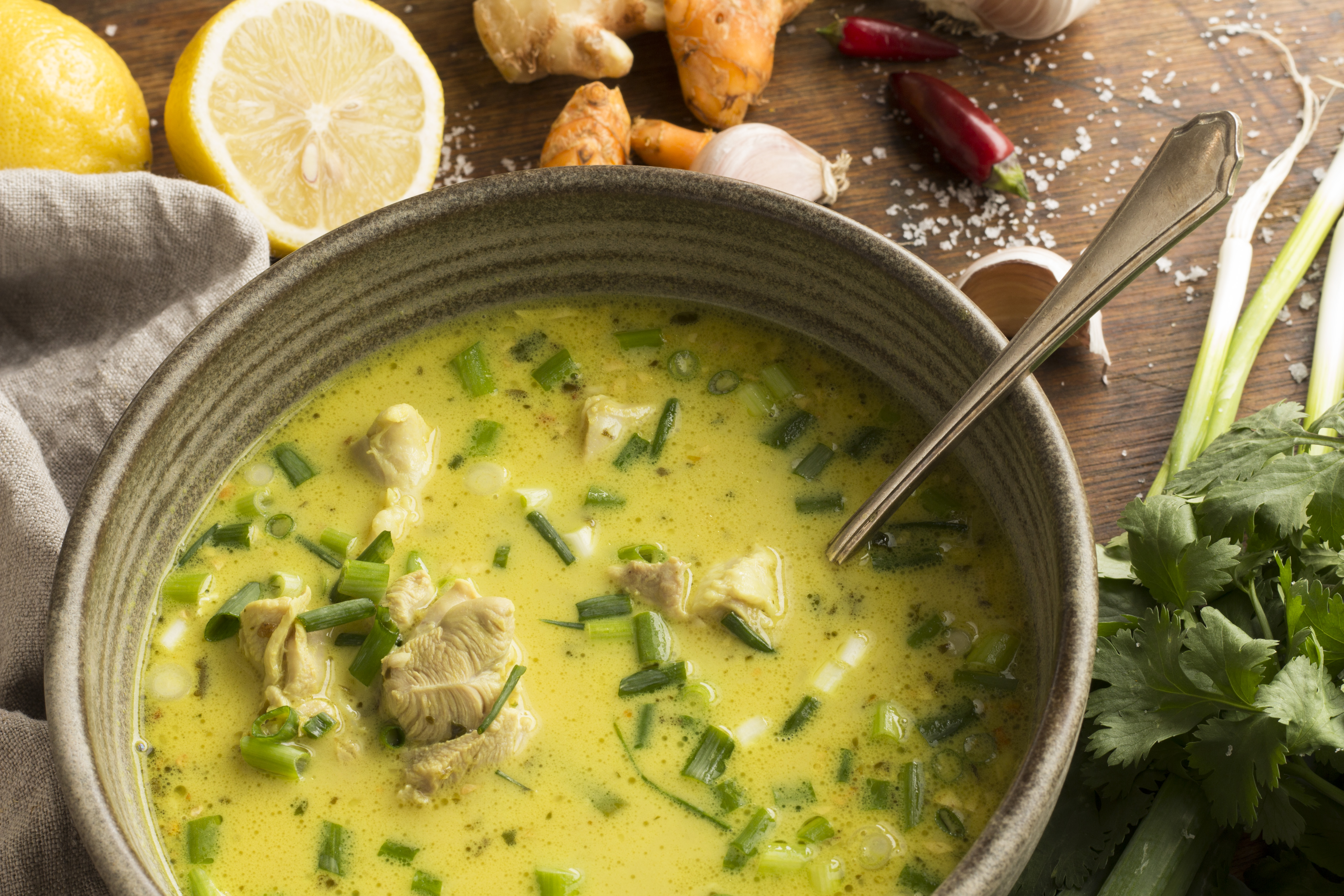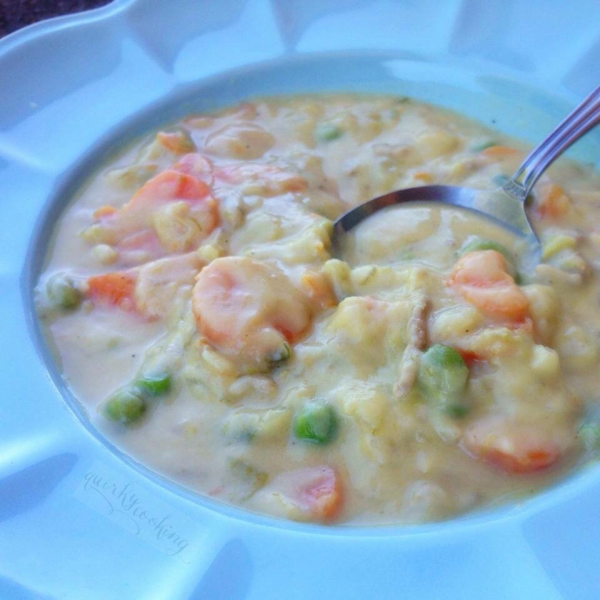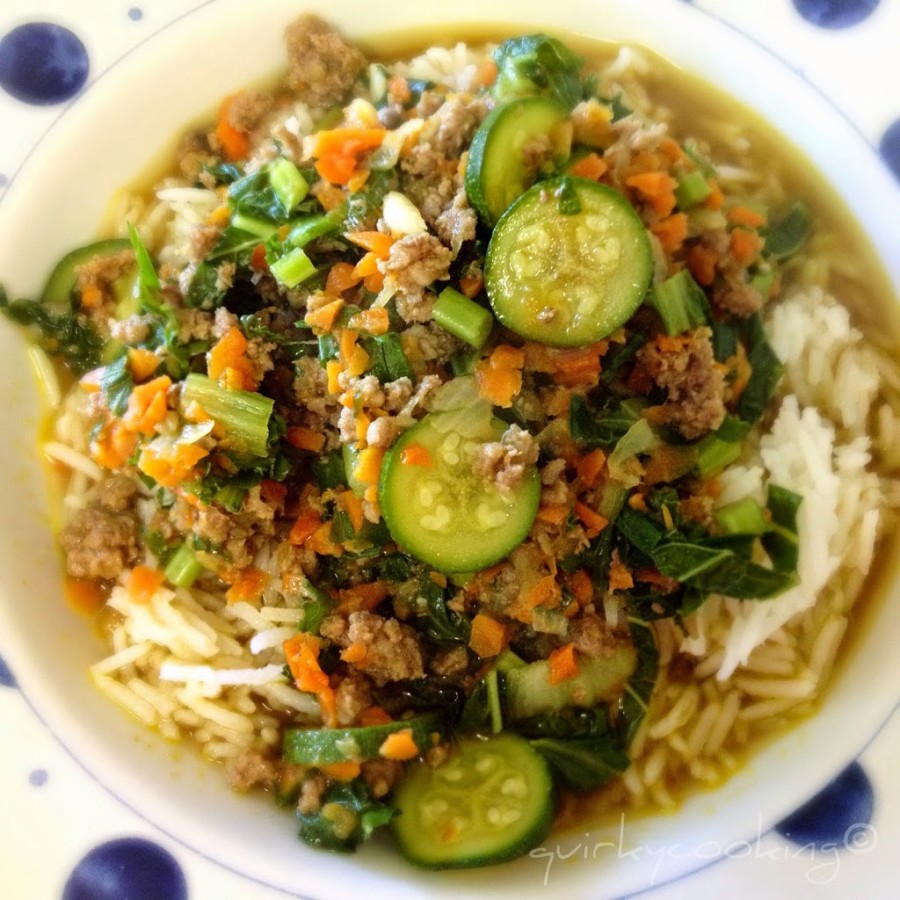No products in the cart.
Chicken, Dairy Free, GAPS, Gluten Free, Grain Free, Gut Health, Health, Health Tips, Healthy Living, Lunches, Meat, Paleo, Soups, Vegetables, Wholefood
Bone Broths & Meat Stocks

Liquid gold.
Our great grandmothers knew the value of broths and stocks and considered them foundational for both meals and medicine. But somewhere along the way they fell out of everyday use, and stock cubes and packs of insipid factory-made stock took their place. But now they’re making a comeback! And so they should – bone broths and meat stocks are the natural way to beautifully flavour soups, stews, casseroles and sauces, while imparting gut-healing goodness and easy to digest nutrients and minerals.
You’ve probably heard about how good broth is for you. Slow-cooked broths and short-cooked meat stocks are both nutritionally dense foods, containing nutrients and minerals in a form the body can easily absorb. The amino acids in short-cooked meat stocks especially are very powerful for healing and sealing the lining of the digestive tract, and are also anti-inflammatory and calming for a damaged gut. (Bone broths are high in minerals and gelatin from deep within the bones, but the amino acids that build cells are mostly cooked out of a long-cooked broth, so if you are working on healing a damaged gut you’ll be best off starting with short-cooked stocks. See this article for more information.)
You know how when you get a cold, you crave soup? There’s a reason for that. Not only does it feel good on a sore throat, but it really does help to reduce inflammation and actually helps you to get well. This is one of my favourite recipes for when we’re feeling a bit ‘under the weather’ – Coconut Chicken Lemon Soup. You can just feel it doing you good!

I like to have delicious, homemade stocks on hand at all times – they are the base for so many of our meals. For example…
Breakfast: eggs poached in chicken broth, sometimes with some added veggies, or some leftover rice or noodles or avocado

Lunch: add in some veggies, leftover cauliflower mash, and maybe some meat for a quick but very nourishing soup

Dinner: cook up some beef mince, ginger, garlic, chilli, veggies and greens in beef broth for an Asian-style meal, served with rice or mung bean vermicelli

Or make this delicious Chicken & Mushroom Pho based on chicken stock – recipe in our Life-Changing Food cookbook!
If you’ve never made stock or broth before, it’s time to get started, both for the health benefits and the amazing flavour that will add so much more to your meals. Below are some recipes to get you started!
Important Note for People with Gut Issues and/or Amine Intolerance: For those working on healing a damaged gut, you will need to begin with short-cooked meat stocks and move on to bone broths later, as the meat stocks are gentler and easier to digest than stocks. Meat stocks are made with joint bones – meat close to the bone, lots of connective tissue, and gelatinous meats – not the muscle meats. The connective tissues contain the really gelatinous proteins that the body uses as basic building blocks to heal damaged cells and gut lining. Lamb and chicken broths are best to start with as they are lower in amines than beef, fish and pork. See the recipes below for how-to, and get an appointment with a GAPS practitioner if needing more specific advice on healing.
Need Help with Cooking for Gut Health? Our online program, Quirky Cooking for Gut Health, is where we focus on healing with food. We will walk you through how to cook for GAPS Intro (the protocol our family has found most helpful for gut health) and will provide you with meal plans, recipes, cooking videos, and a support group to keep you motivated. Pop over and have a look!
Recipes that are great for using the reserved meat from the chicken:
Chicken Pasta or Chicken Zoodle Soup
Creamy Chicken and Brown Rice Soup
Chicken and Cashews with Coconut Satay Sauce and Coconut RiceFried rice
Paprika Chicken with Creamy Paprika Sauce (an easy all-in-one Thermomix dinner)
Healthy Fried Chicken Strips & Salad
Brown Rice Mushroom Risotto with Macadamia Cheese

Chicken Stock or Broth
Ingredients
- 1 whole, fresh chicken, or approx. 2 kg chicken pieces, or 2 chicken carcasses plus chicken feet if possible (organic, free range chicken is best)
- 3–4 litres filtered water, room temperature
- 2 Tbsp apple cider vinegar (for bone broth)
- 1 large onion, roughly chopped (opt)
- 2 carrots, peeled and roughly chopped (opt)
- 2 cloves garlic, roughly chopped (opt)
Instructions
To make meat stock:
- Place whole chicken or chicken pieces into a slow cooker or a large, heavy-based stock pot, cover with water, add 2 tsp salt and 1 tsp pepper, and add veggies if using.
- In slow cooker: Cook for 4 hours on high, removing any foam that rises to the top.
- On stove top: Bring to a boil over medium heat, then reduce to a low simmer. Remove any foam that rises to the top, cover, and simmer for 2 hours (or 3 if chicken is older).
- Remove meat from bones and place in fridge to use for other meals. Vegetables can be included in soups/stews.
To make bone broth:
- If starting with a whole chicken or chicken pieces, cut meat off bones (as much as you can) and refrigerate to use in other meals. (Meat can be frozen if you bought the chicken fresh.) The fat can be added to the broth as it gives flavour and helps nutrients to be absorbed more easily. OR use chicken carcasses, and chicken feet if available.
- Place the bones, feet, and any fat/scraps into a large, heavy-based stockpot or slow cooker. Add water, vinegar, and veggies if using. (You can add some salt and pepper but just be aware that the broth reduces as it cooks, so don’t add too much.)
- In slow cooker: Cook for 8-24 hours on low heat, skimming off any foam that rises to the top.
- On stove top: Bring to a gentle boil and skim off any foam that rises to the top. Reduce heat, and simmer on low for 6 to 12 hours, depending on your preference. Keep heat on lowest temp and top up water as needed so that the bones are always covered. If there is meat on the bones, remove once it is cooked and soft (eg. 2 hours) and refrigerate to use in meals, then continue cooking bones.
- Once broth is finished, remove bones, veggies, etc from broth and strain. Pour the broth into into jars/glass containers. Discard bones and vegetables.
Notes
Storage:
- Store stock or broth in the fridge for up to a week, or freeze for up to 6 months. If freezing in jars, make sure you use good quality glass jars, leave a space at the top of the jar for liquids to expand, and don’t put the lid on until completely frozen, to prevent burst jars!
Notes:
- Cooking time is very individual – if you are sensitive to amines, cook your meat stock for only 2 hours then cool and freeze immediately. As your gut heals, you can slowly increase cooking times.
- Amines increase the longer you cook the broth. Older meat will also be higher in amines, so buy very fresh meat/bones from a butcher.
- If you’re drinking stock as a gut-healing ‘medicine’, just warm up half a cup on the stovetop, add a little sea salt and freshly minced garlic (and turmeric and ginger if you like), and sip like a cup of hot tea at least once a day. Also add to meals, as per suggestions above.
- Once cold, the stock should be a bit jelly-like, and there will be a layer of fat on top. Keep the fat to use in cooking, or just stir into the stock/broth when using it in soup/stew.
Meat Stocks & Bone Broths (Beef & Lamb)
Ingredients
- 2kg beef or lamb bones – for stock, use meat on the bone (eg. ox tail, shin, lamb shanks); for broth, use a mixture of marrow, knuckle and meat bones
- 3 litres filtered water (approx.), room temperature
- ¼ cup of apple cider vinegar (for broth)
- 1 large brown onion, roughly chopped (opt)
- 2 carrots, roughly chopped (opt)
- salt and pepper
Instructions
To make meat stock
- Place meat on the bone into a large, heavy-based stock pot or slow cooker, cover with water, add 2 tsp salt and 1 tsp pepper, and add veggies if using.
- In slow cooker: Cook for 4-6 hours on high, removing any foam that rises to the top.
- On stove top: Bring to a boil over medium heat, then reduce to a low simmer. Remove any foam that rises to the top, cover, and simmer for approx. 4 hours.
- Strain off stock to glass containers. Remove meat from bones and place in fridge to use for other meals.
To make bone broth
- Place the bones, water, vinegar, and veggies (if using) into a large, heavy-based stockpot or slow cooker. (You can add some salt and pepper but just be aware that the broth reduces as it cooks, so don’t add too much.)
- In slow cooker: Simmer on low for 8 to 24 hours, depending on your preference.
- On stove top: Bring to a gentle boil and remove any foam that rises to the top. Reduce heat and simmer for 6 to 12 hours, depending on your preference. Keep heat on lowest temp and top up water as needed so that the bones are always covered. If there is meat on the bones, remove once it is cooked and soft (eg. 2 hours) and refrigerate to use in meals, then continue cooking bones.
- Once broth is finished, remove bones, veggies, etc from broth and strain. Pour the broth into glass containers. Discard bones and vegetables.
Notes
Storage
- Store stock or broth in the fridge for up to a week, or freeze for up to 6 months. If freezing in jars, make sure you use good quality glass jars, leave a space at the top of the jar for liquids to expand, and don’t put the lid on until completely frozen, to prevent burst jars!
Notes
- Cooking time is very individual – if you are sensitive to amines, cook your meat stock for only 2 hours then cool and freeze immediately. As your gut heals, you can slowly increase cooking times.
- Amines increase the longer you cook the broth. Older meat will also be higher in amines, so buy very fresh meat/bones from a butcher.
- If you’re drinking stock as a gut-healing ‘medicine’, just warm up half a cup on the stovetop, add a little sea salt and freshly minced garlic (and turmeric and ginger if you like), and sip like a cup of hot tea at least once a day. Also, add to meals as per suggestions above.
- Once cold, the stock should be a bit jelly-like, and there will be a layer of fat on top. Keep the fat to use in cooking, or just stir into the stock/broth when using it in soup/stew.

Hi Jo
I was wondering if there is another veg I could use for the chicken broth instead of celery? I cant stand the smell 🙁
just leave it out 🙂
Hi Jo
Just wondering with the Chicken broth, can I sub the celery for another vegetable? I’m really not a big fan :(. Thank you 🙂
Just leave it out
Can I just put the whole chicken in the slow cooker raw from the fridge and cook a broth this way? remove the chicken when the meat is done and put the bones back in the pot? will this be effective?
Yes!
I’ve just made beef bone broth and now it has solidified, I’ve scraped the fat off the top but all that has remained is a jelly like substance. What have I done wrong?
Nothing, that is perfect!! You’ve made the best stock 🙂 The gelatine in the stock is what is so healing. When you heat it up it will liquify.
HI – I was wonderIng If It was possIble to do the bone broth In the ThermomIx ?
No you really need to make it in a big stock pot or slow cooker that can hold the bones.
Hi Jo, Is there any reason/s why ham or pork bones aren’t suggested to use for making bone broths?
You can use them, and they are delicious! Just be aware that if you’re just starting out on broths, pork broth can be a bit too rich for some. Make it the same way as you make beef broth.
Can i use uncooked frozen chicken bones? Can i then freeze?
Yes!
Just wondering on your thoughts about cooking broths in a stainless steel pressure cooker, are they as good health wise as slow cooking! Thanks
Hey, I wonder if you have tried bone broth in the thermomix and if you see any issues doing it in there for 40 mins vs in a pot for hours?
Hi Ness, you won’t get the same result as you really need a good 2 hours at least, and it won’t make much in the Thermomix. Best to do it in a big stock pot on the stove.
Hi Jo, I made some chicken broth last night but after being in the fridge overnight it is still liquid not like jelly and is very bland. I cooked a whole chicken in the slow cooker on high for 4hrs removed the meat and continued cooking the bones for another 2hrs. Any idea what I would have done wrong? Thanks
I usually do it in a pot on the stove on low for three hours, and then remove meat as the flavour is better on a higher simmer than in a slow cooker.
It will also gel this way.
🙂
Hello Jo
I’m attempting to cook your chicken broth today and I would like to clarify that I can buy a whole chicken (raw) and place it in the pot leave it simmer away for 2hours , take the chicken out and remove the meat and then put bones back in for another hour then strain and put in container?
Thank you
Yep, you can!
I defrosted my chicken bone broth in the fridge over the weekend but didn’t get to it straight away – how many days do you think it can stay in the fridge once defrosted from frozen?
Hi Jo, can you use a mixture of raw and cooked chicken bones? Thanks, Jeni
Please can you explain if a pressure cooker is ok to use?
Hi Jenny, yes it is – I don’t have one so can’t offer advice on it though! Sorry!
Hi Jo,
I have a 6 litre electric Bellini pressure cooker and was wanting to cook broth in it. Just wondering if you have any tips for doing so.
Thanks
Just wondering how long you can keep the broth in the fridge? Or is it best to freeze it. I have had some in there for 2 weeks but not sure if it’s any good now?
Hi Jo
May seem silly, but is long cooked duck stock ok? I added lemongrass-just because this is what I had and seemed silly to throw away. Cooked for 12 hours. Thanks!
Hi Clare, yes duck stock is great! Best to make sure it comes from an ethically raised farm.
Hi Jo, do I bring to the boil and simmer with the lid on or off? Thanks in advance.
Hi Alison! 🙂 Lid on. xx
I truly enjoy drinking bone broth every night!
It has helped get rid of my rheumatoid arthritis and overall
pain a lot. I also used to be more sensitive to certain food types.
I believe the bone broth has helped my digestion within this area.
It seems that I also have more energy now that I have
added bone broth in my routine. What do you think about
drinking it with a collagen pill for enhanced health benefits?
I might try it out.
So glad that you’re enjoying your daily broth. we all love it too;-).You are already getting collagen from the broth:-)so any other supplementation is up to you;-).
I was wondering if after slow cooking uncooked whole chicken & veggies , do you use that same liquid to do your broth ? Or are these 2 separate processes.
I wouldn’t slow cook whole chicken for longer than 3 hours or the meat will be tough. 2-3 hours is enough for a meat stock. Then once you’ve removed the meat from the bones, if you want to add the bones back to the stock and cook a few more hours that would be a bone broth. 🙂
Hi Jo can you buy a cooked chook and remove the meat and put the carcass and skin in for the bone broth?
You can but you won’t get the benefits of the amino acids from the cartilage and joints as much as you do from a meat stock. I prefer to use meaty bones from raw, you’ll also get better flavour this way.
Can you do the bone broth in the Thermomix?
No sorry, you need to use a stock pot on the stovetop as it needs to simmer for a fair while, and you’d have bones bumping around in the Thermomix bowl if you did it in there (and you wouldn’t be able to make much at a time)!
Hi, Can you put chicken and beef bones together in a broth?
Can you put chicken and beef bones together in a broth?
Yep! It’s just different flavours and you usually use them for different dishes. Chicken is more subtle and beef is more robust!
Hi Jo, I have been roasting my bones first before making my bone broth. Is this necessary please? Thank you.
Bone broth is different to meat stock and you don’t need to roast them before making meat stock, here’s a video to get some more info 🙂 https://www.youtube.com/watch?v=bo4KLoiKTv4
Is it possible to use goat meat for stock?
As long as it’s meat on the bone it’ll be fine! Any meat on the bone is fine to use for stock!